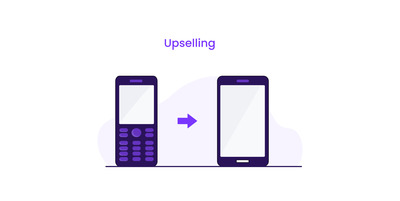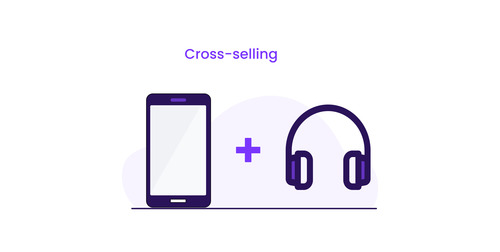
Upselling and cross-selling: the solution for your sales growth
You are a dedicated merchant with a well-functioning online store. You want to increase your sales and drive the growth of your business. One possible strategy is to use upselling and cross-selling in your web store. Both are proven strategies in sales and marketing that help businesses increase shopping cart content and increase shopping cart sales. Both approaches aim to get customers to buy additional products or upgrades. In this guide, we want to show you how to use these tools successfully.
Upselling - definition
Upselling refers to selling a more expensive product or a higher value version of the same product to the customer. It involves converting the customer from a basic product to a premium product by showing them the benefits and added value of the more expensive product.
Upselling - an example
Example: Your customer is on your site and is looking for a new smartphone. He already has his eye on a particular model, but wait! Does he know that there is an upgraded version of this smartphone that is even more powerful and impressive? If not, he'll be grateful to have discovered the latest model. Upselling means offering the customer a product that exceeds his expectations.

Upselling - Upgrades für your customers
Once your customer has selected a product, present them with possible upgrades. For example, if the customer buys a vacuum cleaner, this could be a model that includes a special brush for dog hair. Often, useful accessories are already included in the product package without the customer having to purchase them separately.
Cross-Selling Definition
Cross-selling refers to the sale of complementary or related products to the product that the customer has already purchased. The goal is to offer the customer products that complement or enhance their main product.
Cross-Selling - an example
A customer ordering new running shoes from your online store might also be interested in matching sportswear to complete their outfit. Ideally, the whole package would then fit perfectly into a new sports bag. By actively using cross-selling as a sales strategy, shopping becomes a holistic experience for your customer that excites and inspires them.

Differences between upselling and cross-selling
The main difference between upselling and cross-selling is the nature of the offer. Upselling offers the customer a more expensive product, while cross-selling offers additional products that complement the main product.
Upselling focuses on increasing revenue per transaction by convincing the customer to buy a higher value product. Cross-selling, on the other hand, aims to increase the average value of the order by selling additional products.
Advantages of upselling and cross-celling
Upselling and cross-selling offer several benefits to companies:
- Increased revenue: selling more expensive products or additional items increases revenue per transaction and overall sales.
- Customer retention: By offering customers relevant complementary products, they feel well taken care of and are more likely to purchase from the company again.
- Customer satisfaction: upselling and cross-selling enable customers to discover products that can better meet their needs or enhance their experience.
Advices for a successful upselling and cross-Selling
- Identify your target audience: understand your customers' needs, preferences and buying habits so you can tailor offers to them.
- Analyze their purchase history, interests and preferences. This will help you identify relevant products or services that may be of interest to them.
- Offer added value: Show customers the benefits and added values of the more expensive products or additional items to pique their interest.
- Place relevant offers: Make sure upsell and cross-sell offers are presented at appropriate points during the buying process to grab customers' attention.
How to put this into practice?
In TYRIOS, you can assign different items so that they are made visible to your customer during the buying process. In the case of the smartphone, these are newer or performance-optimized models (upselling) and useful accessories such as charging cables, smartphone cases and car mounts. It is considered proven that the customer is particularly receptive to purchasing additional items at the time of purchase (cross-selling). Both possibilities, up-selling and cross-selling can be easily integrated into your store and are visually attractively incorporated into the buying process.
A little help: select products from the same merchandise and price group (size, color, scope of delivery, etc.) that reflects the customer's purchasing power. Someone looking for a low-budget smartphone will certainly not order a new iPhone.
Challenges
Although upselling and cross-selling are effective strategies, there are also challenges that should be considered:
- Ease of use: for online stores with a large range of goods, an inventory management system like TYRIOS is the perfect solution. The individual articles are automatically assigned to the relevant merchandise groups. This eliminates the need for time-consuming and laborious manual assignment of items, and the system spits out the appropriate up-sell or cross-sell products (TYRIOS has this feature)
- Overwhelming customers: Too many offers can confuse and overwhelm customers. It is important to make the offers targeted and relevant.
- Customer acceptance: not all customers are willing to buy additional products or upgrade to more expensive versions. It is important to understand customer needs and act respectfully.
Conclusion
Upselling and cross-selling are effective strategies to increase sales and strengthen customer relationships. Both approaches have their own characteristics and advantages. By understanding the differences and applying the right tactics, companies can successfully integrate these strategies into their sales and marketing strategies.
